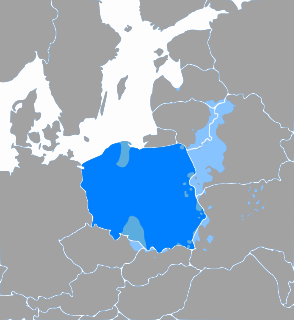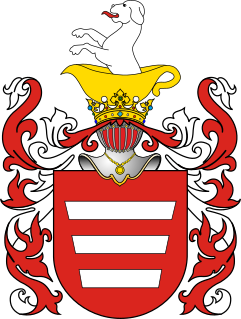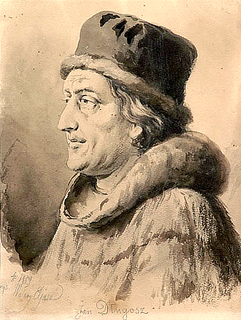
Wałbrzych(listen) is a city in Lower Silesian Voivodeship in southwestern Poland. From 1975–1998 it was the capital of Wałbrzych Voivodeship; it is now the seat of Wałbrzych County. Wałbrzych lies approximately 70 kilometres (43 mi) southwest of the voivodeship capital Wrocław and about 30 kilometres from the Czech border. It has a population of about 113,600 which makes it the second-largest city in the voivodeship and the 33rd largest in the country.
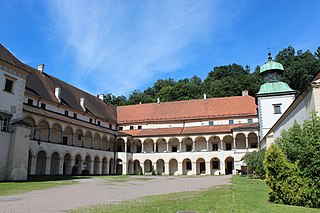
Sucha Beskidzka is a town in the Beskid Żywiecki mountain range in southern Poland, on the Skawa river. It is the county seat of Sucha County. It has been in the Lesser Poland Voivodeship since 1999; previously it was in Bielsko-Biała Voivodeship (1975–1998).

Zator is an old town on the Skawa river within Oświęcim County, Lesser Poland Voivodeship in southern Poland. From 1975 to 1998 it belonged to the Bielsko-Biała Voivodeship. It is the administrative seat of the Gmina Zator. According to data from December 31, 2008, Zator was inhabited by 4779 people.

The Royal Castle in Warsaw is a castle residency that formerly served throughout the centuries as the official residence of the Polish monarchs. It is located in the Castle Square, at the entrance to the Warsaw Old Town. The personal offices of the king and the administrative offices of the Royal Court of Poland were located there from the sixteenth century until the Partitions of Poland.

Princess Teofila Ludwika Zasławska was a member of the Polish nobility, known as the perhaps most significant heiress and landowner of her contemporary Poland.

Chudów is a village in the district of Gliwice County, within the municipality of Gmina Gierałtowice, Silesian Voivodeship, in the historical region of Silesia. It lies approximately 3 kilometres (2 mi) east of Gierałtowice, 12 km (7 mi) south-east of Gliwice, and 16 km (10 mi) west of the regional capital Katowice. The village has a population of 1,493 (2012).
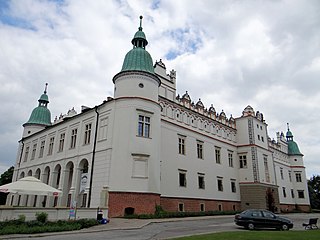
The Baranów Sandomierski Castle is a Mannerist castle located in the town of Baranów Sandomierski in the Subcarpathian Voivodship, south-eastern Poland. It is one of the most important Mannerist structures in the country. The castle is commonly known as the "little Wawel". Originally a residency of the Lubomirski family, it now serves as a historical museum, hotel and conference centre.

Toszek Castle - a Renaissance styled castle, located in Toszek (23 km away from Gliwice, Silesian Voivodeship in Poland.

Bolków Castle - a castle located in Bolków on the Castle Hill, with a 396 metres, where the hillside is cut by the Nysa Szalona river, with a sharp precipice ; the eastern side of the hill gradually lowers, taken up by the town. The castle is an upland stronghold, covering an area of 7600 m². The castle is located in Bolków, Lower Silesian Voivodeship; in Poland.
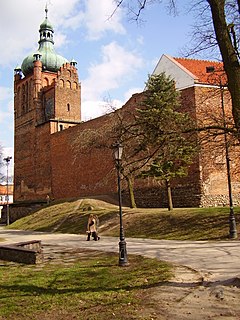
The Castle of the Masovian Dukes in Płock is a Gothic castle built under the reign of Casimir III the Great, becoming a stronghold of the Dukes of Masovia until the fifteenth century. The castle is located in the Princely Capital City of Płock, Masovian Voivodeship; in Poland.

Żupny Castle is a Gothic castle, the former headquarters of the Wieliczka and Bochnia Salt Mine. The castle is located in the former mine complex and was designated as part of the Wieliczka and Bochnia UNESCO World Heritage Site, since an expansion in 2013. The castle is located in Wieliczka, Lesser Poland Voivodeship, in Poland.

Gołuchów Castle is an early Renaissance castle built between 1550-1560 on a square plan and used as a defensive stronghold and residence. The castle is located in Gołuchów, Greater Poland Voivodeship; in Poland.

Reszel Castle is a castle located in Reszel by the bank of the river Sajna, in the south-east of the town.

Liw Castle - a ruin of a Gothic ducal castle raised in the fifteenth century as a guarding stronghold in the town of Liw. The castle is located in Liw, Masovian Voivodeship; in Poland.

Oleśnica Castle is a castle in Oleśnica, Lower Silesian Voivodeship, southwestern Poland. It was erected in 1542-1561, replacing a Gothic fortress from the thirteenth century. It was the seat of the Dukes of Oleśnica until the nineteenth century. A fortified settlement was mentioned before the year 1238, and the first record of the castle dates from 1292. After World War II, the surviving buildings held Hungarian and Italian prisoners of war. Later, there was the Soviet branch office of the International Committee of the Red Cross. In the 1970s the castle underwent another renovation and it became a branch of the Archaeological Museum in Wroclaw, until abandoned in 1993. It has since been reoccupied by the Voluntary Labour Corps.

Międyrzecz Castle - a castle surrounded by a dike, raised in around 1350 by Casimir III the Great in the place of a former gord from the second half of the ninth century, located on a small hill in between two floodplains of the Obra and Paklica Rivers.

The Co-Cathedral of the Nativity of the Blessed Virgin Mary also called Żywiec Cathedral It is the main Catholic religious building in the city of Zywiec, Poland, and the co-cathedral of the Diocese of Bielsko-Zywiec.
